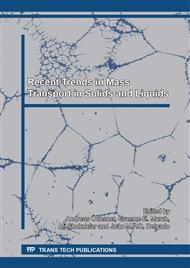p.120
p.124
p.135
p.141
p.151
p.161
p.167
p.173
p.181
Carbon Dioxide Hydrogenation to Methanol over Cu/ZnO-SBA-15 Catalyst: Effect of Metal Loading
Abstract:
Utilization of CO2 as a carbon source to produce valuable chemicals is one of the important ways to reduce the global warming caused by increasing CO2 in the atmosphere. Supported metal catalysts are crucial to produce clean and renewable fuels and chemicals from the stable CO2 molecules. The catalytic conversion of CO2 into methanol is recently under increased scrutiny as an opportunity to be used as a low-cost carbon source. Therefore, a series of the bimetallic Cu/ZnO-based catalyst supported by SBA-15 were synthesized via an impregnation technique with different total metal loading and tested in the catalytic hydrogenation of CO2 to methanol. The morphological and textural properties of the synthesized catalysts were determined by transmission electron microscopy (TEM), temperature programmed desorption, reduction, oxidation and pulse chemisorption (TPDRO), and N2-adsorption. The CO2 hydrogenation reaction was performed in a microactivity fixed-bed system at 250oC, 2.25 MPa, and H2/CO2 ratio of 3. Experimental results showed that the catalytic structure and performance were strongly affected by the loading of the active site. Where, the catalytic activity, the methanol selectivity as well as the space-time yield increased with increasing the metal loading until it reaches the maximum values at a metal loading of 15 wt% while further addition of metal inhibits the catalytic performance. The higher catalytic activity of 14% and methanol selectivity of 92% was obtained over a Cu/ZnO-SBA-15 catalyst with a total bimetallic loading of 15 wt%. The excellent performance of 15 wt% Cu/ZnO-SBA-15 catalyst is attributed to the presence of well dispersed active sites with small particle size, higher Cu surface area, and lower catalytic reducibility.
Info:
Periodical:
Pages:
151-160
Citation:
Online since:
November 2017
Price:
Сopyright:
© 2017 Trans Tech Publications Ltd. All Rights Reserved
Share:
Citation:


